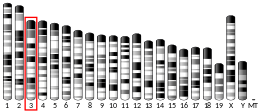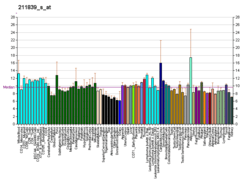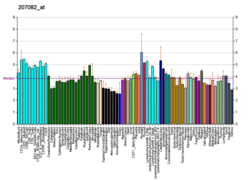Macrophage colony-stimulating factor
The colony stimulating factor 1 (CSF1), also known as macrophage colony-stimulating factor (M-CSF), is a secreted cytokine which causes hematopoietic stem cells to differentiate into macrophages or other related cell types. Eukaryotic cells also produce M-CSF in order to combat intercellular viral infection. It is one of the three experimentally described colony-stimulating factors. M-CSF binds to the colony stimulating factor 1 receptor. It may also be involved in development of the placenta.[5]
Structure
M-CSF is a cytokine, being a smaller protein involved in cell signaling. The active form of the protein is found extracellularly as a disulfide-linked homodimer, and is thought to be produced by proteolytic cleavage of membrane-bound precursors.[5]
Four transcript variants encoding three different isoforms (a proteoglycan, glycoprotein and cell surface protein)[6] have been found for this gene.[5]
Function
M-CSF (or CSF-1) is a hematopoietic growth factor that is involved in the proliferation, differentiation, and survival of monocytes, macrophages, and bone marrow progenitor cells.[7] M-CSF affects macrophages and monocytes in several ways, including stimulating increased phagocytic and chemotactic activity, and increased tumour cell cytotoxicity.[8] The role of M-CSF is not only restricted to the monocyte/macrophage cell lineage. By interacting with its membrane receptor (CSF1R or M-CSF-R encoded by the c-fms proto-oncogene), M-CSF also modulates the proliferation of earlier hematopoietic progenitors and influence numerous physiological processes involved in immunology, metabolism, fertility and pregnancy.[9]
M-CSF released by osteoblasts (as a result of endocrine stimulation by parathyroid hormone) exerts paracrine effects on osteoclasts.[10] M-CSF binds to receptors on osteoclasts inducing differentiation, and ultimately leading to increased plasma calcium levels—through the resorption (breakdown) of bone. Additionally, high levels of CSF-1 expression are observed in the endometrial epithelium of the pregnant uterus as well as high levels of its receptor CSF1R in the placental trophoblast. Studies have shown that activation of trophoblastic CSF1R by local high levels of CSF-1 is essential for normal embryonic implantation and placental development. More recently, it was discovered that CSF-1 and its receptor CSF1R are implicated in the mammary gland during normal development and neoplastic growth.[11]
Clinical significance
Locally produced M-CSF in the vessel wall contributes to the development and progression of atherosclerosis.[12]
M-CSF has been described to play a role in renal pathology including acute kidney injury and chronic renal failure.[13][14] The chronic activation of monocytes can lead to multiple metabolic, hematologic and immunologic abnormalities in patients with chronic renal failure.[13] In the context of acute kidney injury, M-CSF has been implicated in promoting repair following injury,[15] but also been described in an opposing role, driving proliferation of a pro-inflammatory macrophage phenotype.[16]
As a drug target
PD-0360324 and MCS110 are CSF1 inhibitors in clinical trials for some cancers.[17] See also CSF1R inhibitors.
Interactions
Macrophage colony-stimulating factor has been shown to interact with PIK3R2.[18]
References
- GRCh38: Ensembl release 89: ENSG00000184371 - Ensembl, May 2017
- GRCm38: Ensembl release 89: ENSMUSG00000014599 - Ensembl, May 2017
- "Human PubMed Reference:". National Center for Biotechnology Information, U.S. National Library of Medicine.
- "Mouse PubMed Reference:". National Center for Biotechnology Information, U.S. National Library of Medicine.
- "Entrez Gene: CSF1 colony stimulating factor 1 (macrophage)".
- Jang MH, Herber DM, Jiang X, Nandi S, Dai XM, Zeller G, Stanley ER, Kelley VR (September 2006). "Distinct in vivo roles of colony-stimulating factor-1 isoforms in renal inflammation". Journal of Immunology. 177 (6): 4055–63. doi:10.4049/jimmunol.177.6.4055. PMID 16951369.
- Stanley ER, Berg KL, Einstein DB, Lee PS, Pixley FJ, Wang Y, Yeung YG (January 1997). "Biology and action of colony--stimulating factor-1". Molecular Reproduction and Development. 46 (1): 4–10. doi:10.1002/(SICI)1098-2795(199701)46:1<4::AID-MRD2>3.0.CO;2-V. PMID 8981357.
- Nemunaitis J (April 1993). "Macrophage function activating cytokines: potential clinical application". Critical Reviews in Oncology/Hematology. 14 (2): 153–71. doi:10.1016/1040-8428(93)90022-V. PMID 8357512.
- Fixe P, Praloran V (June 1997). "Macrophage colony-stimulating-factor (M-CSF or CSF-1) and its receptor: structure-function relationships". European Cytokine Network. 8 (2): 125–36. PMID 9262961.
- "Paracrine and endocrine actions of bone—the functions of secretory proteins from osteoblasts, osteocytes, and osteoclasts". Retrieved 12 July 2018. Cite journal requires
|journal=(help) - Sapi E (January 2004). "The role of CSF-1 in normal physiology of mammary gland and breast cancer: an update". Experimental Biology and Medicine. 229 (1): 1–11. doi:10.1177/153537020422900101. PMID 14709771.
- Rajavashisth T, Qiao JH, Tripathi S, Tripathi J, Mishra N, Hua M, Wang XP, Loussararian A, Clinton S, Libby P, Lusis A (June 1998). "Heterozygous osteopetrotic (op) mutation reduces atherosclerosis in LDL receptor- deficient mice". The Journal of Clinical Investigation. 101 (12): 2702–10. doi:10.1172/JCI119891. PMC 508861. PMID 9637704.
- Le Meur Y, Fixe P, Aldigier JC, Leroux-Robert C, Praloran V (September 1996). "Macrophage colony stimulating factor involvement in uremic patients". Kidney International. 50 (3): 1007–12. doi:10.1038/ki.1996.402. PMID 8872977.
- Lim, G. B. (2013-01-01). "Acute kidney injury: CSF-1 signalling is involved in repair following AKI". Nature Reviews Nephrology. 9 (1): 2. doi:10.1038/nrneph.2012.253. ISSN 1759-5061. PMID 23165301.
- Zhang MZ, Yao B, Yang S, Jiang L, Wang S, Fan X, Yin H, Wong K, Miyazawa T, Chen J, Chang I, Singh A, Harris RC (December 2012). "CSF-1 signaling mediates recovery from acute kidney injury". The Journal of Clinical Investigation. 122 (12): 4519–32. doi:10.1172/JCI60363. PMC 3533529. PMID 23143303.
- Cao Q, Wang Y, Zheng D, Sun Y, Wang C, Wang XM, Lee VW, Wang Y, Zheng G, Tan TK, Wang YM, Alexander SI, Harris DC (April 2014). "Failed renoprotection by alternatively activated bone marrow macrophages is due to a proliferation-dependent phenotype switch in vivo". Kidney International. 85 (4): 794–806. doi:10.1038/ki.2013.341. PMID 24048378.
- Interest Builds in CSF1R for Targeting Tumor Microenvironment
- Gout I, Dhand R, Panayotou G, Fry MJ, Hiles I, Otsu M, Waterfield MD (December 1992). "Expression and characterization of the p85 subunit of the phosphatidylinositol 3-kinase complex and a related p85 beta protein by using the baculovirus expression system". The Biochemical Journal. 288 (2): 395–405. doi:10.1042/bj2880395. PMC 1132024. PMID 1334406.
Further reading
- Rajavashisth T, Qiao JH, Tripathi S, Tripathi J, Mishra N, Hua M, Wang XP, Loussararian A, Clinton S, Libby P, Lusis A (June 1998). "Heterozygous osteopetrotic (op) mutation reduces atherosclerosis in LDL receptor- deficient mice". The Journal of Clinical Investigation. 101 (12): 2702–10. doi:10.1172/JCI119891. PMC 508861. PMID 9637704.
- Stanley ER, Berg KL, Einstein DB, Lee PS, Yeung YG (1995). "The biology and action of colony stimulating factor-1". Stem Cells. 12 Suppl 1: 15–24, discussion 25. PMID 7696959.
- Alterman RL, Stanley ER (1994). "Colony stimulating factor-1 expression in human glioma". Molecular and Chemical Neuropathology. 21 (2–3): 177–88. doi:10.1007/BF02815350. PMID 8086034.
- Stanley ER, Berg KL, Einstein DB, Lee PS, Pixley FJ, Wang Y, Yeung YG (January 1997). "Biology and action of colony--stimulating factor-1". Molecular Reproduction and Development. 46 (1): 4–10. doi:10.1002/(SICI)1098-2795(199701)46:1<4::AID-MRD2>3.0.CO;2-V. PMID 8981357.
- Sweet MJ, Hume DA (2004). "CSF-1 as a regulator of macrophage activation and immune responses". Archivum Immunologiae et Therapiae Experimentalis. 51 (3): 169–77. PMID 12894871.
- Mroczko B, Szmitkowski M (2005). "Hematopoietic cytokines as tumor markers". Clinical Chemistry and Laboratory Medicine. 42 (12): 1347–54. doi:10.1515/CCLM.2004.253. PMID 15576295.
- Pandit J, Bohm A, Jancarik J, Halenbeck R, Koths K, Kim SH (November 1992). "Three-dimensional structure of dimeric human recombinant macrophage colony-stimulating factor". Science. 258 (5086): 1358–62. doi:10.1126/science.1455231. PMID 1455231.
- Suzu S, Ohtsuki T, Yanai N, Takatsu Z, Kawashima T, Takaku F, Nagata N, Motoyoshi K (March 1992). "Identification of a high molecular weight macrophage colony-stimulating factor as a glycosaminoglycan-containing species". The Journal of Biological Chemistry. 267 (7): 4345–8. PMID 1531650.
- Saltman DL, Dolganov GM, Hinton LM, Lovett M (February 1992). "Reassignment of the human macrophage colony stimulating factor gene to chromosome 1p13-21". Biochemical and Biophysical Research Communications. 182 (3): 1139–43. doi:10.1016/0006-291X(92)91850-P. PMID 1540160.
- Praloran V, Chevalier S, Gascan H (May 1992). "Macrophage colony-stimulating factor is produced by activated T lymphocytes in vitro and is detected in vivo in T cells from reactive lymph nodes". Blood. 79 (9): 2500–1. doi:10.1182/blood.V79.9.2500.2500. PMID 1571567.
- Price LK, Choi HU, Rosenberg L, Stanley ER (February 1992). "The predominant form of secreted colony stimulating factor-1 is a proteoglycan". The Journal of Biological Chemistry. 267 (4): 2190–9. PMID 1733926.
- Pampfer S, Tabibzadeh S, Chuan FC, Pollard JW (December 1991). "Expression of colony-stimulating factor-1 (CSF-1) messenger RNA in human endometrial glands during the menstrual cycle: molecular cloning of a novel transcript that predicts a cell surface form of CSF-1". Molecular Endocrinology. 5 (12): 1931–8. doi:10.1210/mend-5-12-1931. PMID 1791839.
- Stein J, Borzillo GV, Rettenmier CW (October 1990). "Direct stimulation of cells expressing receptors for macrophage colony-stimulating factor (CSF-1) by a plasma membrane-bound precursor of human CSF-1". Blood. 76 (7): 1308–14. doi:10.1182/blood.V76.7.1308.1308. PMID 2145044.
- Sherr CJ, Rettenmier CW, Sacca R, Roussel MF, Look AT, Stanley ER (July 1985). "The c-fms proto-oncogene product is related to the receptor for the mononuclear phagocyte growth factor, CSF-1". Cell. 41 (3): 665–76. doi:10.1016/S0092-8674(85)80047-7. PMID 2408759.
- Cerretti DP, Wignall J, Anderson D, Tushinski RJ, Gallis BM, Stya M, Gillis S, Urdal DL, Cosman D (August 1988). "Human macrophage-colony stimulating factor: alternative RNA and protein processing from a single gene". Molecular Immunology. 25 (8): 761–70. doi:10.1016/0161-5890(88)90112-5. PMID 2460758.
- Takahashi M, Hirato T, Takano M, Nishida T, Nagamura K, Kamogashira T, Nakai S, Hirai Y (June 1989). "Amino-terminal region of human macrophage colony-stimulating factor (M-CSF) is sufficient for its in vitro biological activity: molecular cloning and expression of carboxyl-terminal deletion mutants of human M-CSF". Biochemical and Biophysical Research Communications. 161 (2): 892–901. doi:10.1016/0006-291X(89)92683-1. PMID 2660794.
- Kawasaki ES, Ladner MB, Wang AM, Van Arsdell J, Warren MK, Coyne MY, Schweickart VL, Lee MT, Wilson KJ, Boosman A (October 1985). "Molecular cloning of a complementary DNA encoding human macrophage-specific colony-stimulating factor (CSF-1)". Science. 230 (4723): 291–6. doi:10.1126/science.2996129. PMID 2996129.
- Rettenmier CW, Roussel MF, Ashmun RA, Ralph P, Price K, Sherr CJ (July 1987). "Synthesis of membrane-bound colony-stimulating factor 1 (CSF-1) and downmodulation of CSF-1 receptors in NIH 3T3 cells transformed by cotransfection of the human CSF-1 and c-fms (CSF-1 receptor) genes". Molecular and Cellular Biology. 7 (7): 2378–87. doi:10.1128/mcb.7.7.2378. PMC 365369. PMID 3039346.
- Takahashi M, Hong YM, Yasuda S, Takano M, Kawai K, Nakai S, Hirai Y (May 1988). "Macrophage colony-stimulating factor is produced by human T lymphoblastoid cell line, CEM-ON: identification by amino-terminal amino acid sequence analysis". Biochemical and Biophysical Research Communications. 152 (3): 1401–9. doi:10.1016/S0006-291X(88)80441-8. PMID 3259875.
- Rettenmier CW, Roussel MF (November 1988). "Differential processing of colony-stimulating factor 1 precursors encoded by two human cDNAs". Molecular and Cellular Biology. 8 (11): 5026–34. doi:10.1128/mcb.8.11.5026. PMC 365596. PMID 3264877.
- Wong GG, Temple PA, Leary AC, Witek-Giannotti JS, Yang YC, Ciarletta AB, Chung M, Murtha P, Kriz R, Kaufman RJ (March 1987). "Human CSF-1: molecular cloning and expression of 4-kb cDNA encoding the human urinary protein". Science. 235 (4795): 1504–8. doi:10.1126/science.3493529. PMID 3493529.
External links
- Macrophage+Colony-Stimulating+Factor at the US National Library of Medicine Medical Subject Headings (MeSH)
- Overview of all the structural information available in the PDB for UniProt: P09603 (Macrophage colony-stimulating factor 1) at the PDBe-KB.





